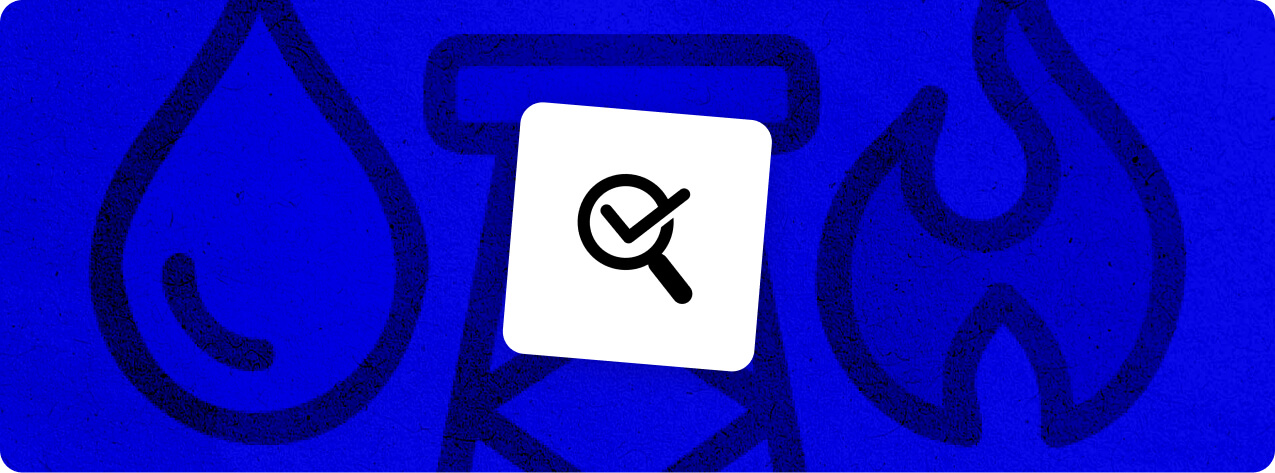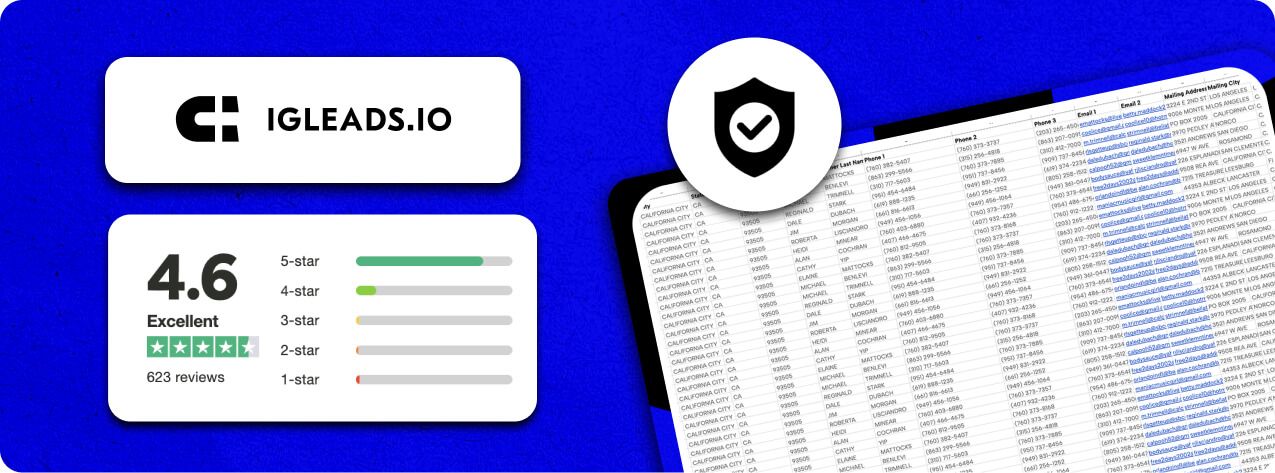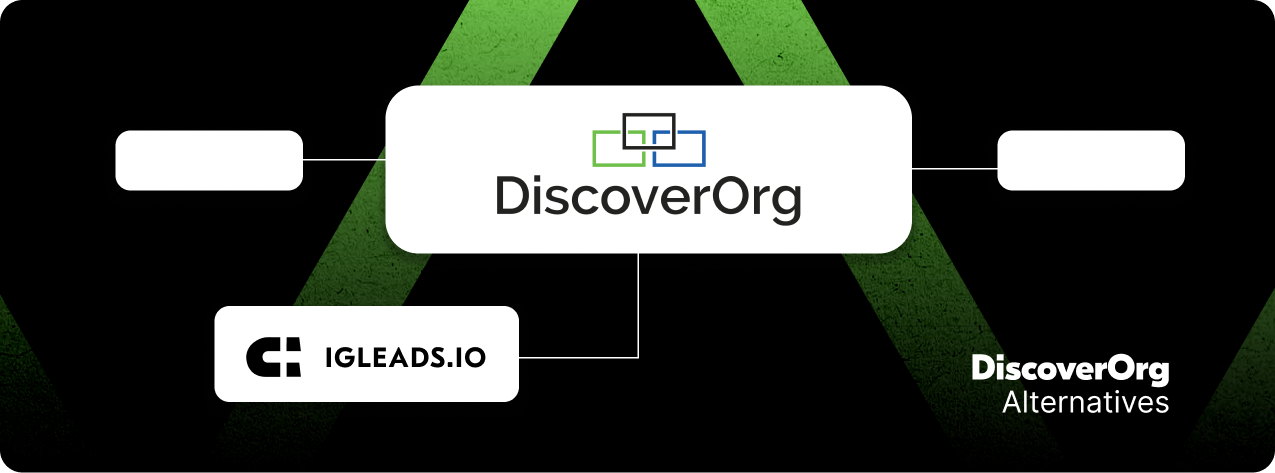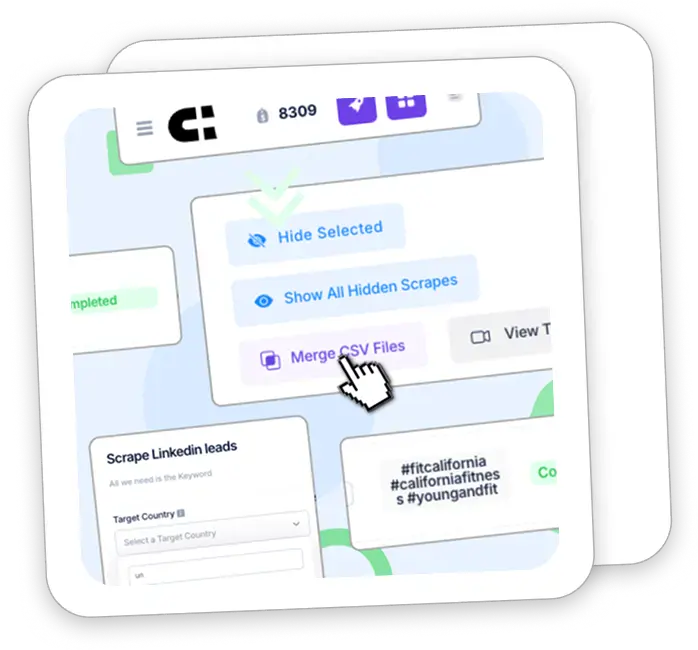Oil And Gas Industry Email List 2025

Reaching decision-makers in the oil and gas sector is no easy task. It’s a specialized, high-value industry where contacts are often siloed behind outdated directories or generic databases. That’s why having an accurate and segmented oil and gas industry email list can be a game-changer for B2B marketers, recruiters, and sales teams.
Whether you’re selling equipment, offering financing, or promoting industrial SaaS, you need access to the right people—procurement managers, field engineers, directors of operations, and more. Some teams rely on an email scraper to gather this data from online sources, but the quality and structure of those lists can vary dramatically.
Most public or scraped lists are:
- Missing key roles or company data
- Outdated or non-compliant
- Filled with generic company emails, not decision-makers
To generate real pipeline, you need contact records that include full names, job titles, company names, email addresses, phone numbers, and industry filters, plus high deliverability rates to avoid wasting your send limits.
In this guide, we’ll break down how to build or buy an oil and gas contact list that actually performs. We’ll compare free sources, industry directories, and scraping platforms like IGLeads that offer fast, automated access to oil & gas leads with filtering and real-time enrichment built in.
Why oil and gas email lists still matter in 2025
Despite being one of the most complex and capital-intensive sectors in the world, the oil and gas industry still runs on relationships, and email is the channel that drives most of them.
From upstream exploration to downstream logistics, the industry is filled with highly specialized roles and long sales cycles. Getting in front of the right person early can make or break a deal.
Decision-makers are spread across departments
The oil and gas sector includes a wide range of professionals, from site engineers and procurement officers to HSE managers and operations directors. These aren’t just technical experts—they’re budget holders, equipment buyers, and compliance authorities.
The best email lists let you reach:
- Procurement and supply chain teams
- Operations and field service directors
- Health and safety managers
- Finance and compliance executives
- Midstream and logistics personnel
Whether you’re offering hardware, consulting services, SaaS tools, or energy financing, each contact has a role to play in the purchasing process.
Why email still works in industrial sectors
Email remains the most effective way to connect with oil and gas professionals for three big reasons:
- Asynchronous communication – Field teams may be offshore or on site, making email the preferred, non-intrusive channel
- Archivable and traceable – High-stakes industries rely on communication records, quotes, and RFPs, making email the default
- Easy to forward internally – When a proposal lands in the wrong inbox, email makes it easy to pass it to the right decision-maker
Email also gives you room to explain technical value propositions, link to spec sheets, and invite the recipient to schedule a demo, without pressure.
How targeted outreach drives performance
A segmented oil and gas industry email list lets you build campaigns that speak directly to your buyer:
- Upstream: Talk drilling equipment, safety protocols, and exploration tools
- Midstream: Focus on logistics, inspection systems, and infrastructure monitoring
- Downstream: Highlight automation, refinery optimization, and retail energy tech
Segmenting by role and location leads to more opens, better replies, and higher deal velocity, especially in global markets where regional needs differ.
Best ways to find an oil and gas industry email list
Building a targeted oil and gas email list means knowing where professionals in the sector are visible, and how to extract their contact data in a scalable, reliable way.
Here are the most effective methods in 2025, ranked by ease of use and data quality:
Use industry directories and trade platforms
Start with trade association websites and business directories that specialize in oil and gas. Examples include:
- Oil & Gas Journal Buyer’s Guide
- Energy People Directory
- Rigzone company listings
- Yellow Pages and Manta for regional service providers
These platforms often include company contacts, websites, and job roles. You can then enrich those contacts with tools like IGLeads or Hunter.io.
Pros
- Industry-specific filters
- Company size and service area often included
- Great for small service providers and vendors
Cons
- Often lacks emails, manual lookup required
- Data may be outdated or spread across sources
Search LinkedIn by role and company type
LinkedIn allows you to filter contacts by:
- Industry (Oil & Energy, Petroleum, Utilities)
- Job title (e.g., “HSE Manager,” “Procurement Director”)
- Company headcount and location
You can also use Sales Navigator for advanced filtering, or use IGLeads to scrape public LinkedIn data at scale.
Pros
- Updated profiles maintained by the professionals themselves
- High precision for targeting decision-makers
- Relationship-based outreach possible
Cons
- Email addresses not publicly visible
- Manual contact gathering unless you use a scraper
- Time-consuming at scale
Use Google Maps + IGLeads for vendors and suppliers
Many oil and gas vendors (especially regionally-based service companies) list their contact details on Google Maps. These include pipeline contractors, equipment rental firms, and inspection companies.
IGLeads allows you to scrape Google Maps results filtered by keywords like:
- “Oilfield services near Houston”
- “Pipeline inspection companies in Alberta”
- “Offshore drilling equipment suppliers”
Case study: An industrial supplier scraped 1,300+ oil and gas vendor contacts from Google Maps using IGLeads and booked 11 calls within 5 days from their cold email campaign.
Pros
- Public contact data (email, phone, website)
- Great for local suppliers, logistics teams, and field ops
- Automatable and exportable
Cons
- Less effective for top-level enterprise roles
- Data freshness depends on business listing updates
Buy or build a list with IGLeads
IGLeads offers specialized scraping tools to build oil and gas contact lists in minutes, not weeks. Use Google Maps, LinkedIn, or domain-based scraping to extract:
- Name
- Title
- Company
- Email address
- Phone number
- Website and industry filters
You can preview the list before exporting and enrich leads with optional social or domain data.
Pros
- Fast, scalable, and affordable
- Filtering by role, region, or service type
- Export to CSV and sync with CRM
Cons
- Requires your own campaign strategy
- Email warming and personalization still necessary
What to check before buying an oil and gas email list
Not all contact lists are created equal. The oil and gas industry has unique needs, and if your data is missing job titles, location info, or firmographics, your campaign performance will suffer.
Here’s what to verify before buying any oil and gas email list:
Is the data fresh and validated?
This sector moves fast. Companies merge, rename, relocate, or close due to market volatility. That means email lists go stale quickly.
Reputable vendors update their databases every 30–90 days and use both AI validation and human verification to remove bad data. Ask about:
- Bounce rate benchmarks
- Replacement guarantees for invalid contacts
- How often they refresh company and role data
If the vendor can’t explain their verification process—or avoids the question—that’s a red flag.
Can you filter by job role or sector?
You should be able to segment contacts by:
- Role: Operations Manager, Field Engineer, Procurement Lead, etc.
- Sector: Upstream, midstream, downstream
- Location: City, state, or international region
- Company size: Headcount or revenue
This kind of filtering helps you create tailored messages for specific segments—boosting open rates and minimizing unsubscribes.
What’s the average deliverability rate?
Deliverability matters more than total list size. You should aim for:
- 90–95% deliverability from top providers
- Bounce rates under 8% with warmed domains
- Replacement credits for invalid or bounced emails
Some vendors even let you preview a sample of your filtered list before buying, always a good sign.
Is the list customizable for your campaign?
Look for export options like:
- CSV format with clean headers
- Optional enrichment fields (phone number, website, social media, revenue)
- Location filters and industry tags
One-size-fits-all lists waste money and email volume. If a vendor can’t tailor your dataset, you’re better off scraping your own list with a tool like IGLeads.
How to choose a reliable oil and gas email list provider
When you’re targeting one of the world’s most regulated and capital-heavy industries, choosing a high-quality data vendor isn’t optional—it’s essential. A bad list can damage your sender reputation, waste outreach budget, and delay deals.
Here’s what to look for in a trustworthy provider:
Look for real-time data collection
Top providers source contacts in real time, pulling from updated business directories, map listings, or professional platforms like LinkedIn. IGLeads, for example, allows you to scrape fresh contacts on-demand, ensuring the data hasn’t been sitting on a server for months.
Ask your vendor:
- How often do you update your lists?
- What sources do you use?
- Do you offer previews before purchase?
If they dodge these questions or can’t share sourcing details, move on.
Check for industry-specific filtering
You shouldn’t be paying for generic energy-sector contacts when you only want pipeline inspectors or midstream procurement leads. The best providers allow filters like:
- Job title
- Company name or type
- Region or city
- Sector (upstream, midstream, downstream)
Precision = performance.
Evaluate the price-to-quality ratio
Cheap lists with no filters usually mean:
- Higher bounce rates
- Generic company emails (e.g., info@ or sales@)
- Zero targeting, just a data dump
Expect to invest between $300 and $900 for a reliable, filtered oil and gas list depending on size and provider. A good list pays for itself in replies, calls, and qualified leads.
Check for transparency, reviews, and guarantees
Top vendors will offer:
- Deliverability guarantees (90%+ is standard)
- Bounce-back replacements or credits
- Transparent refund or data quality policies
Bonus: Look for testimonials that include specific results like “booked 5 calls in 3 days” or “bounced under 5%”—not just generic praise.
Trust indicators: Why IGLeads is a reliable data partner
When working in high-value industries like oil and gas, trust matters. At IGLeads, we prioritize data accuracy, compliance, and automation, so you can focus on selling, not cleaning spreadsheets.
Here’s why marketers and industrial teams trust us:
Public and B2B-compliant sourcing
IGLeads only pulls contact data from publicly available sources such as Google Maps, LinkedIn, and business websites. That means every record is legally sourced, transparent, and ready for B2B outreach when used properly.
We never resell private databases or scrape behind paywalls, keeping you on the right side of compliance.
GDPR and CAN-SPAM aligned
Our platform supports responsible email marketing by aligning with major compliance frameworks, including:
- GDPR (for EU data subjects)
- CAN-SPAM (for U.S.-based outreach)
- Public sourcing standards for business contacts
You’re still responsible for following proper email practices, but the data itself is safe to use.
Verified, structured contact records
You can expect:
- Full name and job title
- Company name
- Industry or category
- Email address
- Phone number
- Website or map link
This gives you all the information needed to launch precise, personalized outreach campaigns.
Trusted by over 1,000+ B2B teams
Sales teams, recruiters, and B2B marketers use IGLeads to reach hard-to-find contacts in complex industries. Our platform powers outreach for teams targeting:
“We booked 7 oil and gas calls within 72 hours using IGLeads. Beats any static list we’ve bought.”
— Business Development Manager, Energy SaaS
“Being able to extract contacts by role and region was a game changer. The bounce rate was under 4%.”
— VP of Sales, Industrial Equipment Supplier
Oil and gas email list use cases
Having a verified contact list is just the start, real success comes from how you use it. In 2025, top-performing teams are combining oil and gas email lists with multichannel outreach strategies to generate pipeline fast.
Here’s how sales, marketing, and recruiting teams are putting these lists to work:
Common B2B use cases
Oil and gas email lists enable targeted outreach for a wide range of industries, including:
- Industrial suppliers – Promoting tools, sensors, safety equipment, and machinery
- Software vendors – Offering asset tracking, compliance, or field management platforms
- Recruiters – Filling high-skill roles in operations, safety, and engineering
- Financial services – Marketing insurance, financing, or investment solutions
- Event organizers – Driving attendance for expos, webinars, or energy summits
Whether your goal is lead generation, demos, or partnerships, a segmented list helps you connect with the right person faster.
Use across the energy value chain
Segmenting your outreach by where contacts sit in the energy chain gives your message more relevance:
- Upstream (exploration & drilling): Target procurement, HSE, and field ops roles
- Midstream (transport & storage): Focus on logistics, asset tracking, and maintenance
- Downstream (refining & distribution): Reach IT, operations, and plant managers
Tailoring your messaging by function, role, and geography increases open rates and cuts down wasted outreach.
Real-world campaign examples
Some of the most successful campaigns using oil and gas contacts include:
- Demo offers for offshore inspection drone software
- Equipment rental deals for midstream operators in Texas
- Training course invites for safety compliance officers
- Lead nurturing email sequences for MRO suppliers
These campaigns work because they’re built on relevant contacts, timely messaging, and a real understanding of the buyer’s needs.
Performance & ROI
The oil and gas sector isn’t about mass outreach, it’s about precision. When your email list is accurate and your messaging speaks directly to real operational challenges, the results are measurable.
Here’s what to expect (and optimize) in 2025:
Open and click benchmarks for oil and gas outreach
Email engagement in industrial sectors tends to outperform general B2B when the message is relevant. Based on our user data and current benchmarks:
- Open rate: 25–30% for role-specific messages
- Click-through rate (CTR): 2–4% is solid; 5%+ is excellent
- Reply rate: 2–3% average, higher when using account-based personalization
Keep in mind: subject lines with job-function relevance (e.g. “For your field team”) tend to boost open rates significantly.
How to A/B test your outreach
Even in specialized sectors, testing pays off. Try experimenting with:
- Short vs. long subject lines – Under 40 characters often wins
- Call-to-action wording – “Schedule a demo” vs. “Quick 10-min call?”
- Sender identity – Personal names > company names
- Industry-relevant pain points – Mentioning safety, delays, or compliance
Pro tip: Send campaigns Tuesday to Thursday mornings—avoid Fridays and Mondays when field teams are transitioning or unavailable.
Improving ROI with list segmentation
The more targeted your email list, the more likely you’ll close deals. Segment your outreach based on:
- Job title (HSE Manager vs. Operations Director)
- Sector (upstream vs. downstream)
- Geographic region or regulatory environment
- Project type or company size
Marketers using segmented email lists report 760% higher revenue from email compared to non-segmented campaigns. In oil and gas, it’s not just about reach—it’s about relevance.
Our verdict: the best way to build an oil and gas industry email list
The oil and gas industry is complex, but accessing decision-makers doesn’t have to be.
A well-built oil and gas industry email list helps you reach procurement teams, field leaders, and executives across the energy value chain, without wasting time on bad data or cold calls that go nowhere.
- Use targeted sources like LinkedIn, industry directories, or IGLeads scrapers
- Segment by job title, location, and sector for maximum relevance
- Track open and click performance, and test to keep improving
- Focus your outreach on solving real problems, not just selling features
When you get your list, filters, and messaging right, email becomes one of the most scalable, trackable, and effective tools for connecting with the energy sector.
Essential Guides for Lead Generation
- B2B Lead Generation Solutions – Guide for 2025
- How to Build a High-Quality B2B Email List for Outbound Marketing
- Buy Email Lists for Marketing in 2025: Complete Guide to Business Leads
- Why Scrape Google Maps? Use Cases for Sales, Marketing & SEO
- B2C Lead Generation: The 2025 Playbook
- 15 Best Lead Generation Companies for 2025
- Best B2B email list providers in 2025
- Top Lead Generation Agencies Compared (2025)
- 18 Best B2B Lead Generation softwares in 2025
- Lead Generation Guide: Strategies & Tools for 2025
Frequently Asked Questions
It’s a curated database of professionals and decision-makers in the oil and gas sector. Lists typically include names, job titles, emails, phone numbers, companies, and location details.
Marketers, recruiters, software vendors, equipment suppliers, and event organizers targeting the energy sector can all benefit from a qualified oil and gas contact list.
Yes—when used responsibly. IGLeads sources all data from publicly available B2B-compliant sources. As long as you follow proper outreach practices under CAN-SPAM and GDPR, your emails are legal.
Our users report bounce rates under 5% when using warmed domains and responsible email practices. IGLeads pulls contacts in real time from platforms like Google Maps and LinkedIn.
Yes. You can target upstream, midstream, or downstream professionals, and filter by region, job title, or company type before scraping your list.
Depending on your filters, most users can extract hundreds to thousands of verified oil and gas leads per session using IGLeads.
CSV format, ready to import into your CRM, email tool, or outreach platform. Fields include name, title, email, company, phone number, and website.
Not at all. IGLeads is beginner-friendly, with simple filtering, scraping, and export options, no coding required.





